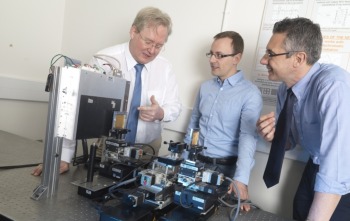
Innovative X-Ray Technologies Enhance Cardiovascular Examinations

Moreover, examinations involving cardiovascular diseases can be carried out without contrast agents. Nearly one out of ten patients suffer from allergic reactions to these substances. A multi-year R&D project, which is scheduled to run until 2017, brings together experts from Siemens Healthcare und Corporate Technology and includes external partners. An article on this subject is now available on the online magazine “Pictures of the Future”.
Instead of emitting electrons from 2,000-degree Celsius filaments as usual, the project's researchers are using a ring-shaped “cold cathode” of nanostructured carbon that operates at a high voltage and at room temperature. As is the case today, electrons are accelerated and collide with a target.
This target, however, is not the usual tungsten anode, which only converts about one percent of incoming energy into X-rays. The new conepts foresees of a jet of liquid metal as the new target. The metal consists of 95 percent lithium and 5 percent heavy elements such as bismuth or lanthanum. The latter produces short wavelength X-rays, the former acts as a coolant.
The energy of electrons leaving the liquid-metal-jet anode can potentially be reclaimed. The result is that the X-ray tube requires less than half the electricity and cooling of previous devices.
20-fold higher imaging resolution
The new tube can achieve a much higher energy density at the target. At the same light intensity, the focus of the new X-ray source is 400 times smaller than in conventional X-ray tubes, which results in a 20-fold higher imaging resolution. That, in turn, is the prerequisite for an entirely new imaging technique: phase-contrast X-ray imaging.
Whereas conventional radiography simply records whether X-rays penetrate certain tissue or not, phase-contrast imaging measures the influence of the tissue on the phase of the X-ray beam. This phase shift varies depending on the refractive power of the tissue through which the radiation passes. This approach would make it possible to distinguish different soft tissues, in particular fat from water or iron levels in blood.
This is essential, for instance, in order to easily identify a tumor in an early stage. Blood vessels could be made visible in this way without contrast agents. To be able to measure these phase shifts, Siemens is using for the first time a wavefront sensor of the kind used in optics and astronomy for X-ray light.
Siemens' next-generation X-ray systems would not only be very efficient to operate and would offer better performance, but would be ideal for minimally invasive surgery. Surgeons performing procedures inside the body via catheter would use X-ray imaging to know exactly where the catheter was located. If the catheter were navigated using magnetic fields, conventional X-ray tubes would not be used because they are sensitive to magnetic fields. The new systems would not have this drawback, but would be able to provide images that would be more useful diagnostically.
Weitere Informationen:
http://www.siemens.com/innovationnews












